|
|
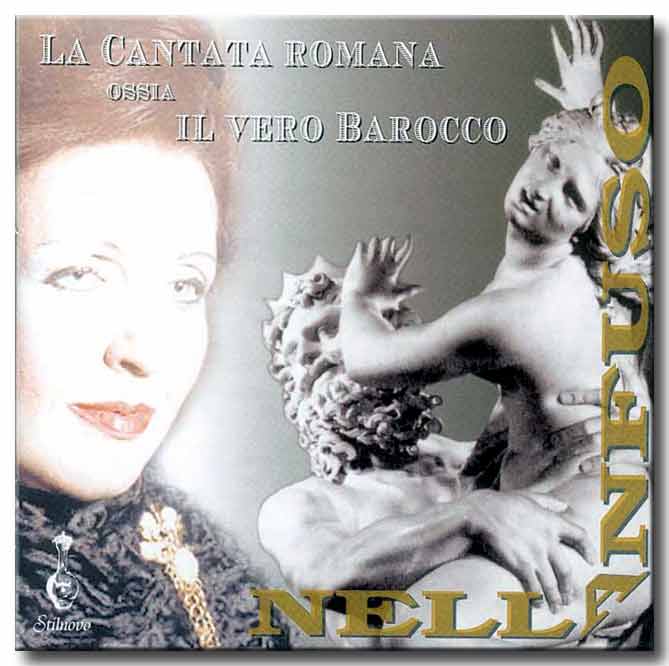 |
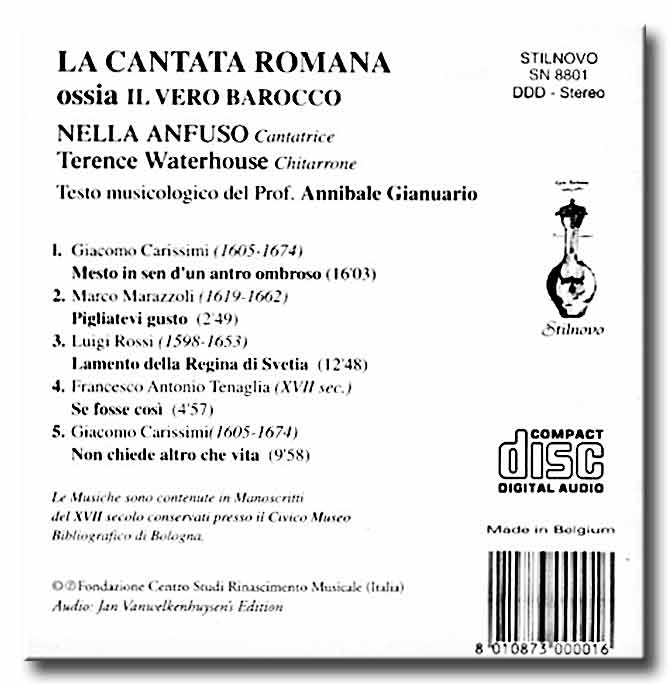 |
|
Nella Anfuso
Cantatrice
Terence Waterhouse
Liuto |
-
Giacomo CARISSIMI
(1605-1674) - [16'00]
Mesto in sen d'un antro ombroso
-
Marco MARAZZOLI
(1619-1662) - [2'48]
Pigliatevi gusto
-
Luigi ROSSI (1598-1653)
- [12'45]
Lamento della Regina di Svetia
|
-
Francesco Antonio TENAGLIA (XVII sec.) - [4'54]
Se fosse così

Exempla - I Pars - download mp3 731 KB |
-
Giacomo CARISSIMI
(1605-1674) - [9'57]
Non chiede altro che vita

Exempla - I Pars - download mp3 1798 KB |
 |

|
| THE ROMAN
CANTATA OR THE TRUE BAROQUE |
|
"You
have been made for Rome and Rome has been made for you"
Urban VIII (1623-1644 alias Maffeo Barberini) said to Bernini and this phrase
underlines the close cultural and aesthetic ties which link Bernini to the
Eternal City rather like an umbilical cord; the City (Urbs) which after having
enriched the world with its civilisation for centuries, at the beginning of the
seventeenth century prepares, once more, to offer the grandiosity and the
magnificence of a style which posterity will to refer as "baroque".
Indeed it will be the Florentine Pope Urban VIII who will give free rein to
Roman life and to Bernini's genius by transforming Rome into the baroque city
"par excellence": "... a broader space was opened up in Rome
in that most celebrated palace in the world to the happy flights of genius of
Gian Lorenzo" (F. Balducci, "Vita del Cav. G.L. Bernini",
Firenze, 1682) (F. Balducci, "The life of Cavalier G.L Bernini",
Florence, 1682).
|
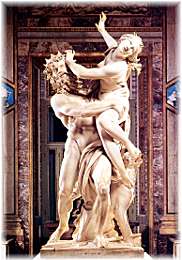 |
 |
|
Bernini was profoundly influenced by
the style of Carracci, Reni, Raphael and Michelangelo and above all by the
lyricism of the classical and ancient works of art on display in the Vatican
where for a period of three years he remained «locked from dawn till the
"Ave Maria" to study them; in front of the Hercules, Venus and
Laocoon he shouted back to his father who called him to assist him: "let me
stay here for I have fallen in love"».
Admired and feted throughout Europe
(with the exception of France where during his séjour in 1665 his forms and
shapes were deemed to be "bizarre lacking any sense of beautiful and
sound architecture") Bernini brought about a renewal in the scuplture
and the architecture of his era (in France too) incorporating a strong charge of
expression which represent the "emotions" (the "affetti"),
the expression of passions which rely on the contrast in light and shade from
which their expressive force is derived. |
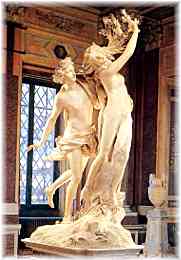 |
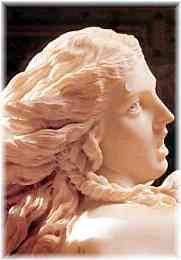 |
|
It is interesting to note the
Italian origin of the French term "bizarre "'. this is used in
the fourteenth and fifteenth centuries to indicate a fiery, impetuous, that is
to say irascible spirit. For example one sees in Dante: " And the
Florentine, a bizarre spirit turned his teeth upon himself" (Inferno,
Canto VIII) and in Boccaccio «we Florentines consider those who suddenly and
for the slightest reason fly into a rage and cannot be persuaded to calm down
for any reason whatsoever as "bizarre"». The term "bizarre"
far from having its present meaning which appears rather to indicate a certain
degree of formal extravagance, but its original meaning clearly concerns
expressive power.
Indeed the "Vocabolario della
Crusca" (Venice, 1679) defines Bizzarro as "hot-tempered,
irascible, quick to anger". The meaning given by Sebastien de Brossard
in his "Dictionnaire de musique" (Paris, 1703) is interesting "Bizzarro,
ou con bizzarria, veut dire (...) tantot vite, tantot lentement, tantot fort,
tantot doucement etc. selon la fantaisie du Compositeur ( Bizzarro
or "con bizzaria" signifies now quickly, now slowly, now
loudly now sweetly etc. according to the fantasy of the Composer)".
As for the term "Baroque
", Montaigne was using the word in the sense of "bizarre" as
early as the sixteenth century. But apart from any consideration regarding the
etymology of the word "baroque" which some maintain is derived
from "barocco" (a syllogistic term) others maintain that it has
its derivation from "barroco" (a Portuguese word indicating an
irregular shaped pearl) yet still others maintain its derivation from the
generally accepted Italian meaning of the word " bizzarro" which
was already used in France in 1533 and in Spain in 1569, the word took on a
meeting at a certain point in time relating to the figurative arts and
architecture of a style characterised by a great vivacity, power and expressive
virtuosity. It is therefore quite logical that this style which encapsulates the
essential themes of contestation and revolt which can even be violent in its
exuberant energy (hence the sense of the Italian "bizzarre" =
litigious/quarrelsome) should have been born in Rome as a reaction to the
anti-roman nature of the Reformation.
Looking at documents which are
extant the same terminology is also valid for the musical arts characterised by
exasperated passions and by an expressiveness which great virtuosity puts into
focus, just as happens in the figurative arts and in architecture. And it is
with these realisations that the Renaissance truly concludes and exalts the
highest significance of its expression; these results can only be obtained with
a technical preparation to the highest standard.
It
is therefore thanks to Bernini, Corelli and to Carissimi that the roman "baroque",
the roman "bizarre" conquers the whole of Europe !
The
magnificence and the richness of a concert in Rome at this period (in 1639) are
well attested and described by André Maugars in his " Réponse faite a
un curieux sur le sentiment de la musique d'ltalie" as we learn from
this telling extract: "... une description du plus celebre et du plus
excellent concert que j'aye ouy dans Rome (...) Tantost un dessus du premier
choeur faisoit un recit, puis celui du 3ème, du 4ème et du 10ème respondoit.
Quelquefois ils chantoient deux, trois, quatre et cinq voix ensemble de
differents choeurs (...). Tantost deux choeurs se battoient l' un contre
l' autre, puis deux autres respondoient (...) ; et au Gloria Patri, tous les dix
choeurs reprenaient ensemble".
We
possess a rich documentation on concerts held in Rome at this time, therefore I
will restrict myself to choosing only a few passages which will illustrate "ad
abundantiam" the spirit which animated musical art in Italy in the
seventeenth century. For example we know that on 31 March 1689 at Rome in the
Palace of Cardinal Pamphilj, the present Palazzo Doria Pamphilj in Piazza Navona,
Arcangelo Corelli conducted a performance of the Oratorio "Beatrice d'
Este " having at his disposal a 100 piece orchestra arranged on two
sides of the concert room - respectively with 80 musicians on one side and 20 on
the other, producing what amounted to a stereophonic effect, "ante
litteram". Corelli played lead violin, the two Gasparini brothers
played the two harpsicords and Bernardo Pasquini played the organ. From the
payment made to the musicians for the performance and this is even more
surprising, we learn that the largest part of the orchestra consisted of 17
violas, 10 double-basses with 40 violins and ten viols. Arcangelo Galli was a
true specialist in performances of this kind. In 1687 in an "Academy of
Music" in the Palace of Queen Christina of Sweden he conducted an
orchestra of 150 musicians no less! This prompts us to ask what then is real "baroque"
music presented to us by contemporary musicians on contemporary discs and
records ! I have referred to stereophonic music - I would add that throughout the
whole of the seventeenth century the "Roman Baroque " had a
taste for "stereophonic" music. In a letter dated Rome,
Mascardi, 1685, ("a letter written by Signor Antimo Liberati in reply to
one from Signor Ovidio Persapegi..." relates how performances in the
Basilica of St Peter's in which choirs and musicians were divided up into groups
of 20 or 40 and placed in different parts of the Basilica, even in the dome in
order to achieve effects which we today would call stereophonic. |
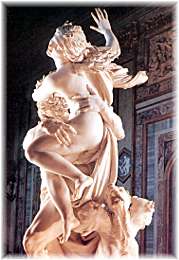 |
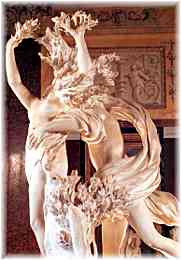 |
|
In another document dated 1640, "Della
musica dell'età nostra... " Pietro Della Valle informs us of another
performance again in the St Peter's of 16 choirs with one choir producing an
echo effect in the dome! Della Valle's "Discorso " is a
particularly important document on musical life in Rome towards the end of the
seventeenth century. Regarding the musical style of his day and the enormous
differences to that of previous eras Della Valle writes "... our
maestros rather than using subtle artifices and devices play on affections and
graces and on the lively expression of the senses to that which is sung; and
that is what truly enraptures and makes us go into ecstasy. They have learned
how to avail themselves even of discordant voices to produce excellent effects
and from the same dissonances they have learned how to produce very melodious
concerts, according to the sayings of that most learned and most wise man
Quintilian who stated that in order to produce good art one must know (observe)
the rules of art and he who does not know these rules is indeed very ignorant,
but the one who at times does not dare occasionally to break these rules in
order to improve achieves and knows even less... ".
After having developed his
dissertation on vocal and instrumental performances, on the artistic and
technical qualities of musicians and singers and after having cited many
performers, Della Valle begins his section on voices and comments : "... But
leaving aside other voices, to concentrate a little on sopranos who are the
greatest embellishment of music you cannot compare the falsetti of those times
with the natural sopranos and castrati which we have in such great abundance in
our own day (...) the most we could hope to do then was to have and train a good
young boy; but by the time they had begun to learn something their voices would
break (...). The sopranos of today are responsible and mature and are
technically very well prepared and sing with grace, with taste and with true
flair; adopting expressions of tenderness they enrapture their audiences (...)
and over and above the castrati where in the past were the excellent female
singers that we can boast of today ?"
At this point Della Valle begins to
compile a long list of names: Giulia or Lolla, Vittoria, Ippolita, Leonora and
Caterina, Adriana, Sofonisba, Cammilluccia, Lucrezia Moretti, Laudomia del Muti,
the Campane and the Valeri sisters up to Cecchina, alias Francesca Caccini, the
only Florentine in a list of Roman singers. He continues with the most
prestigious names of Nuns in Roman Convents. All these "natural Sopranos
" in the natural female octave range, either Castrati or Ladies (including
the Nuns) knew their art exquisitely well "...the art of singing loudly
or softly; of increasing and augmenting the voice little by little and of making
it fade away gracefully, of the expression of tender feeling and emotion, of the
interpretation of the words being sung (the lyrics) and their meaning in a wise
manner; knowing how to make the voice appear happy or knowing how to make it sad
and melancholy; how to make it piteous or bold as the situation dictates"
(See P. Della Valle, op.cit.).
Della Valle's text is very important
not only for learning about and understanding musical life in Rome in the
seventeenth century but also for the history of Italian vocal music: one
witnesses in the middle of the sixteenth century the elimination of "falsettos"
and of "pueri cantores" (even if these fall into the category
of natural voices) in church music; this occurs for reasons of expressiveness
and of virtuosity (virtuosity which is only possible with the fusion of the two
registers- see Monteverdi's letter of 1627)! Among the names of the female
singers recalled by Della Valle one can recognise the names of a few celebrated
singers mentioned in other documents: Vittoria (Archilei), Adriana (Basile,
admired by Monteverdi), Leonora (Baroni the daughter of Adriana Baroni who was
invited by Mazzarin to the French Court who bewildered the French with the new
declaimed style of the Italians!).
Italy which has created all musical
forms is also the creator at the beginning of the seventeenth century of the
Cantata. Initially any piece of vocal music which was "meant to be sung
" was given this name and before assuming a well defined genre being
accorded a precise definition at the end of the century as an Aria with a Da
Capo, during the seventeenth century it takes on different forms : strophic (as
we find for example in Alessandro Grandi -1620 - or in Carlo Milanuzzi - 1635)
composed as an alternation of a Recitative and Aria, Aria with a section with
the function of a Ritornello etc.. Towards the end of the seventeenth century we
find all these different forms of cantata in Italy and above all, in Rome. All
musicians of the day composed cantatas of various types and among the great we
find the greatest of them all, the Roman: Giacomo Carissimi. It is with him and
his pupils among who number the Germans Johann Karl von Kerll and Johan Philipp
Kriger and the Frenchman Marc Antoine Charpentier, that the Italian Cantata (and
the Oratorio, another Roman genre which will enjoy great popularity) will spread
across the whole of Europe.
Another
of Carissimi's pupils, Christoph Bernhard, in his opera "Von der
Singer-Kunst oder Manier", summarises the aesthetics and the style of
Italian vocal music of the period. Bernhard describes various genres : "Contrapunctus",
the "Aequalis" the "Inequalis", the "Gravis"
(Stilus antiquus) and the "Luxurians" (Stilus modernus),
the "Communis" and the "Comicus" (where the
Gravis and the Luxurius correspond to Monteverdi's "Prima Pratica"
and the "Seconda Pratica"); moreover he explains what the three
methods or styles of singing consist of :
"Cantar
alla Romana " singing in the
Roman Style, "Cantar alla Napolitana " singing in the
Neapolitan Style, and "Cantar alla Lombarda" singing in the
Lombard Style which can also be referred to as "Cantar sodo"
singing solidly, "Cantar affettuoso" singing tenderly or
affectionately and "Cantar Passeggiato " ornamented singing.
This disc contains some examples of
the enormous output of profane vocal music (Carissimi alone wrote more than 300
cantatas) of some of the most representative musicians of the Roman school
towards the middle of the seventeenth century-musicians who for the most part
had worked in the service of a great Patron, a member of the Barberini family.
Cardinal Antonio Barberini.
The cantatas on the disc are of
various genres with or without alternation of Recitative and Aria and of varying
length (from the shortest by Marazzoli to the longest - by Carissimi and Luigi
Rossi), written in a lie / tessitura which is rather high (with top
notes) (this is very typical of Roman music of the period), with all the
elements which characterise the "Stilus Luxurians" of which
Bernhard says: "a great expression even to the point of exasperation , a
passionate temperament beyond all measure, chromaticisms and dissonances of
great boldness, the most subtle vocal effects linked to the pronunciation of the
word, pregnant and with essentiality of expression which acquires a particular
relief from the sobriety of the continual Bass (provided by the theorbo)".
An extraordinary example is afforded
in the "Lamento della Regina di Svetia" (The Lament of the
Queen of Sweden) by Rossi, a Cantata-Lament where the announcement of the death
of the King of Sweden Gustave Adolph to Queen Eleanor, the anguish of the Queen
culminating in her madness. Inspired by contemporary historical events which
moved the whole of Europe, the Cantata was offered in homage by its author (Ottavio
Castelli) to Cardinal Richelieu who was in Rome in 1641. If in the Rome of
the Barberini, Leonora Baroni, worthy daughter of Adriana Basile, (was deemed to
be the greatest interpreter of this genre of music the poet Milton who was in
Rome at that period dedicated some poems to her), in our own age we have the
fortune and the great pleasure of having Nella Anfuso who recreates a canto,
a style and an expressive world which characterise that which we call "Baroque".
Annibale Gianuario
|
 |
 |
 |

| |



|
